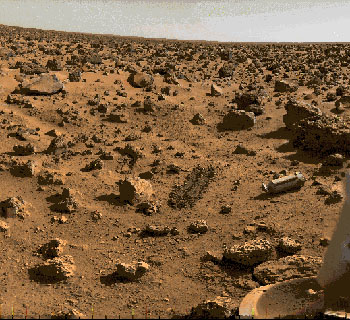Russia flies to Mars in 2014, USA's Martian mission slated for 2030
According to NASA's calculations, the cost of the space project will exceed $100 billion already by 2020
The time, when humans will fly to Mars and land on the mysterious red planet, is drawing near. Russia and the USA are the two countries that traditionally compete in the filed of space exploration. Russia's approach to the goal consists of three aspects. 
Russia plans to use its rich experience of manned flights – the development, assemblage and exploitation of space complexes. Scientists also plan to develop breaking technologies for this purpose and make the project feasible under problematic conditions of the Russian economy.
The above-mentioned requirements outlined the profile of the Russian mission to Mars. The program has been entitled “The Manned Martian Orbital Station.” Four cosmonauts are to fly to the red planet on board an orbital station. The cosmonauts will not walk on Mars, though – they will drop space probes on the planet's surface. The machines will spend a month on Mars to explore the planet and deliver Martian ground samples to the station. The spacecraft will return to the near-Earth orbit and continue working there instead of the Mir and the International Space Station.
The flight to Mars and back will take 2.5 years. When the station returns to the Earth's orbit, the crew will be changed and the craft will perform another voyage to the red planet. That will be the time when a human being will finally touch the surface of Mars. “We have adjusted the Martian complex for the Proton carrier rocket. Twenty-five launches of this reliable rocket will be enough to take the parts of the station to the orbit,” Nikolai Bryukhanov, a spokesman for the Russian Space Corporation said.
Russia's Martian complex will enter the orbit of Mars in 2014 – long before the USA, Europe or China will be able to come closer to this goal. The project has been evaluated in $14 billion – about $1.4 billion a year, which triples the current annual budget of the Federal Space Agency. The cost of the project has been meticulously calculated on the base of the technical, economic issues and industrial capacities of the Russian space industry.
Russia prefers to concentrate intellectual and industrial resources of the national space industry on a certain direction due to restricted financial resources. The USA's approach to the problem is different, though. America's project includes the creation of a new type of a manned spacecraft, which is to be finished by 2014. In addition, American astronauts are to return to the Moon in 2020 and land on Mars after 2030.
The USA's reasonable and complex approach has a good financial ground. The US Congress has recently approved the 6-percent raise to NASA's budget, which now totals $16.2 billion. The American Space Agency, however, delayed several of its scientific programs.
John M. Logsdon, the Director of the Space Policy Institute at George Washington University, stated that George W. Bush had made only a primary contribution (6%) in the implementation of USA's space plans. It will be up to Bush's successors to decide whether the financing of the project should be continued or not. There is something to think about indeed. According to NASA's calculations, the cost of the projects will exceed $100 billion already by 2020. It is not ruled out that the new US administration will simply decide to shut the Martian and Lunar programs down.
More importantly, Russia and the USA might join forces in the space programs, although the USA is determined to accomplish everything alone. If the USA does not send its astronauts to the Moon, someone else will do it instead – China, for example. One may say that America does not perceive Russia as a worthy technological partner in space. Even if the USA takes Russia in its Martian project, it will be done with a view to make Russia work for the American success in the conquest of Mars.
Russia may join forces with the USA, but the Russian technological contribution to the project must be equal to the American one, or it will find itself playing the role of an apprentice with no perspective of becoming a master.
Russia will fly to Mars in 2014, whereas the USA will do it after 2030. The countdown has already started. Technological opportunities of the two countries are more or less identical, but the USA has a significant advantage – money. Russia in its turn has a vital need to take the scientific industry out of stagnation and retrieve the image of a leading technological superpower in the world. The year 2005 will show which of the two factors – the Russian or the American one – is more ponderable.
Subscribe to Pravda.Ru Telegram channel, Facebook, RSS!




